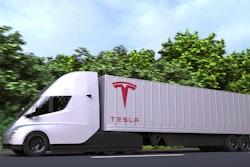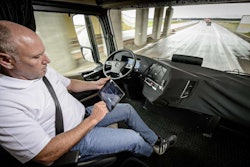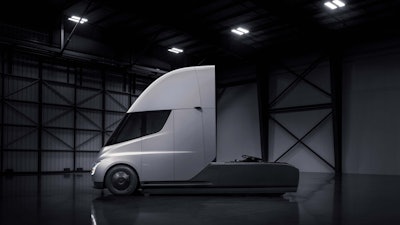 Tesla is accepting reservations for the Tesla Semi, requiring a $5,000 deposit. Production is slated to begin in 2019.
Tesla is accepting reservations for the Tesla Semi, requiring a $5,000 deposit. Production is slated to begin in 2019.After 15 months of much-hyped speculation and teases, electric vehicle pioneer Tesla on Thursday night debuted its Tesla Semi, a Class 8 truck that the company says offers a 500-mile range on a single charge and can tow up to 80,000 pounds.
The truck’s unveiling came in a special event held in Hawthorne, Calif., the home of Tesla Motors’ design center and Tesla founder Elon Musk’s SpaceX rocket factory. The company is currently accepting reservations for Tesla Semi for $5,000 per truck. Production of the Tesla Semi will begin in 2019, the company says.
Without a trailer in tow, Musk says Tesla Semi features a five second 0-60 time, versus about 15 seconds for a comparable diesel truck. At a full-load of 80,000 pounds, he says the electric truck can hit the 60 mph mark in 20 seconds – about a third of the time of a diesel truck – and adds the truck can climb a 5 percent grade at a steady 65 mph. Most diesel Class 8s, he says, would top out around 45 mph on the same grade.
“We wanted a vehicle that feels incredible,” Musk says, “that accelerates like nothing else.”
Musk didn’t offer torque or horsepower figures for the truck.
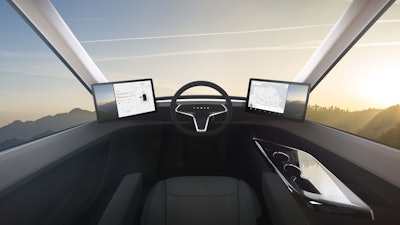 The cockpit of the Tesla Semi features a panoramic windshield, a single seat and two touchscreen displays, borrowed from Tesla’s Model 3 passenger car. The displays on both sides of the driver provide access to navigation, blind spot monitoring and electronic logs.
The cockpit of the Tesla Semi features a panoramic windshield, a single seat and two touchscreen displays, borrowed from Tesla’s Model 3 passenger car. The displays on both sides of the driver provide access to navigation, blind spot monitoring and electronic logs.Tesla says its new high-speed Megacharger DC charging stations, which are proprietary stations in development by the company, can pump about 400 miles of range back into the rig in 30 minutes. Chargers can be installed at origin or destination points, presumably at carrier terminals and shipper/receiver facilities, and along heavily trafficked routes, enabling charging during loading, unloading and driver breaks.

Tesla says the Semi’s battery is similar in composition to the batteries used in its energy products and designed to support repeated charging cycles for over a million miles. The truck’s motors – two on each rear axle – are derived from those deployed in the Model 3 and offer independent torque control.
The truck also features a system called regenerative braking, with kinetic energy from braking being recovered to the rig’s battery. The braking system, Musk says, offers a near infinite brake life. Musk envisions drivers rarely using the footbrake and instead relying mostly on the regenerative braking to stop the tractor.
Tesla’s semi-autonomous driving platform, Enhanced Autopilot – and its suite of Automatic Emergency Braking, Automatic Lane Keeping, Lane Departure Warning and event recording – will be standard on the truck, which is also platooning-enabled.
With no engine, transmission, after-treatment system or differential for upkeep, Tesla lauds the Semi’s reduced maintenance needs. However, Tesla says the most significant cost-advantage comes from savings in energy costs. Coupled with the low and historically less volatile nature of electricity prices – which average $0.12/kWh in the U.S. and can be significantly less for commercial and industrial users – Tesla says Semi owners can expect to reap upwards of $200,000 in savings over a million miles on fuel costs alone.
Further, Musk guarantees the truck will not breakdown for one million miles. In the event one of the motors does suffer a failure, he says there’s little threat to missing a delivery date.
Musk estimates the Tesla Semi will provide a $1.26 cost-per-mile versus a $1.51 diesel cost-per-mile.
Reimagined cockpit
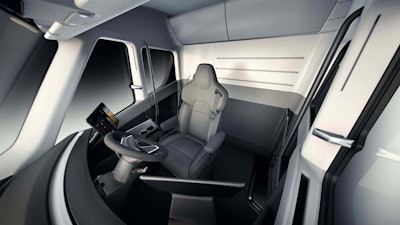
Tesla Semi’s cabin wraps around the center-mounted driver’s seat.
“You’re positioned like you’re in a race car,” Musk says. “You have complete visibility of the road. It’s a beautiful spacious interior.”
The entry-point is behind the center-seat and in the daycab configuration, the passenger seat is mounted to the rear wall on the right-side.
Two touchscreen displays, borrowed from Tesla’s Model 3 passenger car, are positioned on both sides of the driver and provide easy access to navigation, blind spot monitoring and electronic logs.
Built-in connectivity integrates directly with a fleet’s management system to support routing and scheduling and remote monitoring. Each can be flashed over-the-air via updates as-needed.
The truck’s steps are unobstructed, allowing for easier entry and exit. The doors open in reverse, suicide-style, as the company removed the front pillar where the vent-style side windows are now located. Grab handles run from the floor to the top of the door pillar and from the floor to the middle of the door jam, giving it three easy contact points.
The inside is spacious and full standing-height.
The truck’s fully electric HVAC system doesn’t require idling and the interior features deep sill and door pockets, along with overhead storage compartments and pocket storage along the rear wall.
By eliminating the hum of the engine, Tesla has also eliminated the truck’s white noise filter – meaning every other noise stands out even more. To combat that, the company said it trained its focus on ensuring the cab was tightly fit and sealed against creaks and rattles.
The batteries are centered under the truck to lower its center of gravity and give the Semi a more predicable feel, and the air suspension with independent front suspension gives the truck, Musk says, a more comfortable ride.



